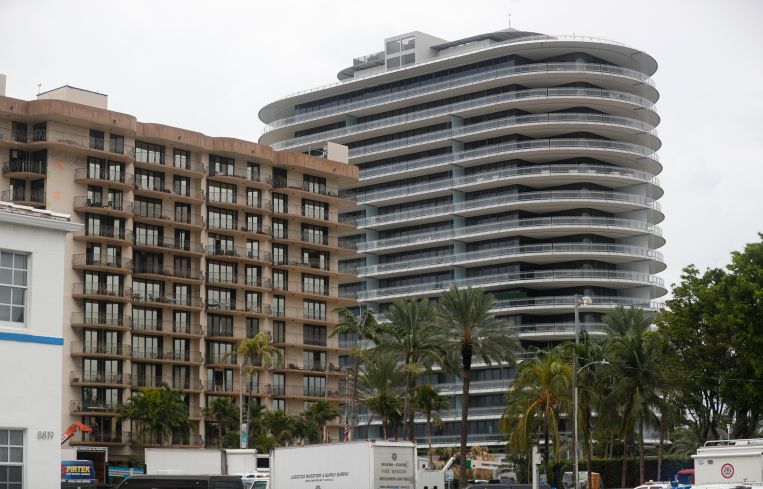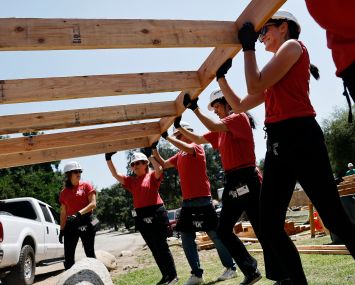David Martin’s Terra Had A Good Year, Despite Lawsuit Over Deadly Condo Collapse
Victims of the Surfside disaster sued Terra over construction of condo next door
By Julia Echikson May 24, 2022 11:45 am
reprints
Before tragedy struck in Surfside, the luxury Eighty Seven Park condominium was the crowning achievement of prolific Miami developer David Martin. Star architect Renzo Piano designed the shimmering 18-story structure. Tennis superstar Novak Djokovic and publishing mogul Jonathan Newhouse bought apartments.
The success of the oceanfront building cemented the remarkable rise of Martin over the past two decades into one of the most recognizable developers in the city.
But, one day last June, Martin’s crown jewel became indelibly tied to a monstrous tragedy.
The building next door, Champlain Towers South, collapsed, destroying 136 apartments and killing 98 people. As the rubble cleared, evidence of prior damage to the Champlain building and the condo board’s mismanagement emerged. A number of individuals came under fire, from Surfside town officials, some of whom had inspected the Champlain building before the collapse, to the condominium’s original developer, now deceased, who allegedly had a history of cutting corners.
Suspicion also shifted to Martin’s Terra and the Eighty Seven Park condo it had developed next door. Champlain residents had long complained about sensing powerful tremors coming from Terra’s construction. Surviving victims and families of the deceased sued Terra, alleging the construction contributed to Champlain’s demise.
Despite the high-profile litigation over a deadly tragedy, Terra hasn’t slowed down — nor has the industry turned its back on the developer. The company continues to launch projects. They sell out. Powerful institutions still want to work with Terra.
Earlier this month, Terra and two dozen defendants reached a landmark settlement, worth $1 billion, with the injured survivors of the Champlain collapse and victims’ families. Now freed from the litigation, the developer will likely accelerate his pace.
Terra’s roots date back to 2001. Martin, fresh out of college at the age of 23, founded Terra with his father, Pedro, a lawyer who fled Cuba as a child following the communist revolution. The firm made a name for itself in Miami for developing different asset classes of all caliber: both low-end and high-end as well as residential, retail, hotels, offices and industrial.
It did so in style. Terra’s developments stood out thanks to their elegant modern flairs. The firm teamed up with rock stars of the architectural world: Rem Koolhaas, Bjarke Ingels and Piano. The Ingels-designed Grove at Grand Bay, a pair of twisting glass condo towers, shattered records for home prices in Coconut Grove soon after its completion seven years ago. The luxury development helped transform the neighborhood from a bohemian center to the billionaires’ enclave it is now.
As his profile rose, David Martin, who took over Terra’s operations over the last decade and now serves as CEO, crafted an image as an industry leader who cared about both the environment and housing affordability — pressing issues in Miami. He believed his developments were part of the solution. When launching projects, Terra sought to “find the business case for any initiative that’s going to do good.” Martin described such an approach as “hacking capitalism” to Commercial Observer in May 2021, about a month before the collapse.
A spokesperson for Terra declined to have Martin interviewed, saying it would be not “appropriate to comment at this sensitive juncture in the litigation.”
A prime example of Terra “hacking capitalism” was Canopy Park, a 3-acre public park that Terra built attached to another luxury condo development in Miami Beach, Five Park. The developer claimed the park functioned as a bioswale — a sort of sponge, absorbing rain and flood water. In some projects, such as Upland Park, Terra is slated to include affordable housing units. His good-guy persona, one who married his high school sweetheart, earned him a flattering profile in the Miami Herald two years ago.
But Terra also allegedly had a history of cutting corners. In 2013, the condo association of the 700-unit Quantum on the Bay complex sued Terra and its contractors for construction defects. Seven years later, so did the association of The Glass, an 18-story luxury condominium at the southern end of Miami Beach completed in 2015. The litigation concerning The Glass is still ongoing, while Terra appears to have settled the other suit three years after its filing.
And, like many developers, Martin leveraged his power to get his way. Terra bought the oceanfront site that would become Eighty Seven Park from Gil Dezer, now CEO of Dezer Development, in 2013. Martin promised to restore the then-existing structure, the Howard Johnson Dezerland Hotel, built in the 1950s.
Martin did something else entirely. In 2014, Terra, acting as the lead developer, and its partners New Valley and Bizzi & Partners unveiled plans to tear down the MiMo-style hotel and redevelop the property. The move stunned and angered locals. “I’m just not sure how we ended up at the last minute with the hotel being demolished,” Philip Levine, then the Miami Beach mayor, said at a town commission meeting. “It’s kind of like a curveball.”
After the initial shock, the Miami Beach government approved Terra’s plans. In 2014, the developer voluntarily donated $10.5 million to the municipality, which granted Terra control of the public walkway along its property that led to the ocean. The deal enlarged the luxury development by almost half an acre, paving the way for additional units.
It also brought it closer to the ailing Champlain building next door — a move that allegedly contributed to its demise.
Once construction began for Eighty Seven Park, Champlain residents complained about their own building shaking. “We are very concerned because of the daily TREMORS,” the Radulescu family, who resided on the fourth floor, wrote to Eighty Seven Park’s project manager, Francisco Canestri, in 2016. “Standing on our balcony we found out a crack on the wall near our balcony. It is not fair, you, Terra Group, are doing your job, our building will be damaged, and our residents lives will be in danger to have apartments walls demolished.”
Construction came to a stop one morning in 2016 after the developer’s seismologist raised concerns about tremors being “too high,” which could damage nearby buildings, according to court filings obtained by the Miami Herald. But, within a half-hour, the work resumed. “Fuck that wall. We have money in the budget to replace it,” Frank Wiza, the site superintendent, told the pile-driving crew, according to a handwritten work log. Court records suggest Wiza was referring to a privacy wall of the Champlain building. It’s unclear if Martin was aware of the pause at the time.
The complaints reached such a fever pitch that in 2019 Terra offered the Champlain condo association $400,000 to keep quiet, The Washington Post reported. The deal would have barred Champlain owners from criticizing the development next door as well as discussing the financial settlement. The condo board never signed the contract.
Two years later, calamity struck. At 1:38 a.m. on June 24, 2021, the eastern portion of the Champlain Towers South condominium pancaked. Fifty-five apartments crumbled. One person was pulled from the rubble. Ninety-eight people died, including two members of the Radulescu family. The collapse was one of the deadliest building failures in modern American history.
Surviving residents and victims’ families sued Terra, along with many of the contractors who worked on Eighty Seven Park, alleging that its construction weakened Champlain’s structure. “For the sake of greed, speed, or, most likely, both, [the defendants] time and again defaulted to the least expensive, but most disruptive and most dangerous, practices for its Eighty Seven Park site-preparation work,” the 164-page complaint, filed in November 2021, states.
The plaintiffs accused Terra of having sloped the base of the development, which caused water to seep into the Champlain building, corroding its structural supports.
The chief accusation revolves around the sheet piles that contractors drove into the ground, producing the strong tremors that allegedly exceeded the “acceptable and safe limits,” according to the class-action lawsuit. A development inspector’s report warned about “damaging vibrations” to the surrounding buildings and offered alternative methods to excavate, which Terra and its partners did not use. Instead, they opted for the conventional method, which the complaint describes as cheaper, faster — and more dangerous — than ones proposed in the report.
Regardless of Terra, the Champlain building had severe issues of its own. Just before the collapse, the condo association had commenced renovations that it had delayed for years, the cost of which had ballooned to $15 million, averaging over $110,000 a unit. Debates among apartment owners about the deteriorating state of the building had become so fraught that some had resorted to litigation. In 2015, Matilde Zaidenweber sued the condo association for $15,000 over water damage in her unit, court records show. A judge dismissed the suit three years later. Some reports have suggested that Champlain’s design was faulty from the start.
Terra categorically denies all wrongdoing. A representative for the development partners said construction for Eighty Seven Park was completed two years before the collapse; vibrations from sheet-pile installation never approached levels that would have damaged reinforced concrete; and Champlain’s privacy wall remained standing even after the building’s collapse. Earlier this month, Terra settled the case, joining the more than 25 entities that agreed to pay a combined billion dollars to the victims’ families and injured survivors.
According to Terra’s lawyer, Michael Thomas, the settlement is “neither an admission of liability nor recognition of the validity of any of the plaintiffs’ claims.” Terra settled only because its insurer — which will pay the full amount that Terra and its partners owe — wanted to “avoid the time, expense, and inconvenience of litigation,” Thomas said, adding, “Hopefully, ending this litigation will help bring some closure to the survivors of this tragic event.” (Miami-Dade Circuit Judge Michael Hanzman, who’s presiding over the case, said he would approve the settlement before the tragedy’s one-year anniversary next month.)
But it’s still unclear the extent to which the developer is at fault for the collapse, if at all. The National Institute of Standards and Technology, a federal governmental agency, has yet to publish its report on the cause of the collapse. It could take years before the agency’s findings come out.
Lawyers representing the plaintiffs admitted to targeting Terra, in part because of its deep pockets. They launched lawsuits against those believed to be at fault, who also happen to be wealthy, to “bring dollars into the estate to compensate the victims,” lead attorney Harley Tropin said in court.
It wasn’t only Terra that settled. A wide range of entities will contribute to the $1 billion agreement, such as contractors that did work on the Champlain building dating as far back as 1996. Even the wealthy residents of Eighty Seven Park will pay, since the building’s condo association, no longer associated with Terra, was named as a defendant.
Despite the lawsuit, Terra remained hard at work.
Just days before the tragedy, the developer closed a deal to buy a 1.8-acre development site in Bay Harbor Islands, a wealthy town north of Miami Beach. Nearly six months later — after being sued — the firm nabbed a considerable loan by Miami standards, $141 million from Mack Real Estate Credit Strategies, to build a mixed-use development.
While the shadow of ligation loomed, Terra got a vote of confidence from a financial giant, Apollo Global Management, one of the country’s largest private equity firms. Just days before Terra was served, the duo, through a joint venture, proposed redeveloping a Downtown Miami parking lot into three mixed-use towers. If selected, Terra would have teamed once again with Desimone Consulting Engineers, one of its contractors from Eighty Seven Park that was also implicated in the Champlain suit. The Miami Parking Authority, which owns the property, ultimately selected a proposal by the Related Group and ROVR Development.
Terra is moving forward with other major projects. Days before the collapse, the Miami-Dade County government approved a lease and development deal with Terra for 43 acres near Dolphin Station, a park & ride terminal on the outskirts of the city. Terra has unveiled plans for a development at the site called Upland Park, which is slated to include 709 apartments, 50,000 square feet for retail and 1,270 parking spots.
Within the coming years, Terra is set to deliver several sizable projects in Miami. Grove Central, a 23-story mixed-use development with 402 residential units and 170,000 square feet of retail near the Coconut Grove Metrorail station, is scheduled to open next year. The long-planned Grand Hyatt Miami Beach hotel, adjacent to the city’s convention center, will likely break ground this year and be completed by 2025.
Buyer appetite is strong for Terra’s units, too. In March, Botaniko Weston, a community of 125 single-family homes near Everglades Park, sold out for $300 million, the developer announced. The sellout averaged an impressive $2.4 million per unit.
Terra also leaned into its long-standing relationships. In the proposal filed to the Miami Parking Authority, Terra had letters of recommendation from former lenders and partners, such as Regions Bank, Synovus Bank and S&K Worldwide Realty. Even the City of Miami Beach government provided a letter, despite the government’s involvement at Eighty Seven Park.
“My interactions with Terra have all been extremely positive and collaborative,” wrote Eric Carpenter, the city manager of Miami Beach’s municipal government. “They are clearly a well-respected organization in our City and have been trusted to navigate construction, development and public buy-in challenges on each of their projects.”
It’s fair therefore to say that Terra has emerged from the incident largely unscathed. Perhaps that’s due to its long track record. A high-profile lawsuit involving a tragedy of this magnitude might have tanked a newer, relatively untested developer, but Terra was already a development heavyweight in Miami, with over two decades of experience under its belt.
In the real estate industry, lawsuits are fairly common, and many notable developers have at some point been embroiled in litigation. The type of settlement that Terra nabbed, in which the developer’s insurance carrier pays and the developer itself admits no fault, is also routine, according to legal experts who spoke with CO.
CO reached out to dozens of real estate professionals, who all declined to comment on the record for this article. Many didn’t want their names associated with anything relating to the deadly condo collapse. And, to some, a lawsuit, even one that involved deaths, didn’t raise the sort of concerns that might end a business relationship.
Others wanted to stay in Terra’s good graces and thought best not to say anything for fear of jeopardizing their relationship with the developer. One publicist, who declined to have any of his clients interviewed for this piece, put it plainly: “They may want to do deals with Terra in the future.”


